Are you considering installing marble countertops in your kitchen or bathroom? Don’t worry, with proper care and maintenance, your marble countertops can last a lifetime.
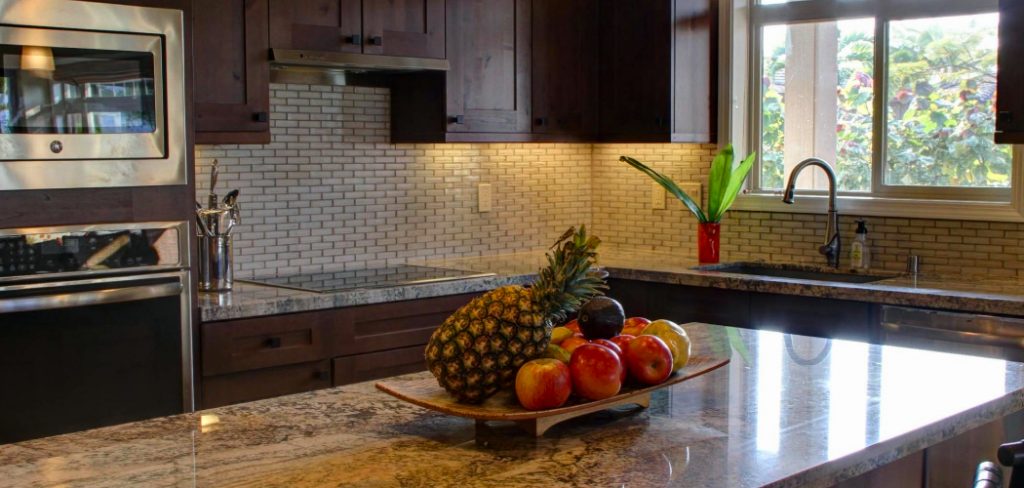
Marble countertops add a timeless beauty and elegance to any space, but they require proper care to maintain their luster and longevity. Marble is a porous natural stone and prone to staining, etching, and scratching if not treated correctly. By understanding the proper cleaning methods, sealing practices, and general maintenance tips, you can keep your marble countertops looking pristine for years to come. Additionally. Knowing how to treat any damage or stains that may occur will help you better care for your marble countertops.
This guide on how to treat marble countertops will provide essential steps and advice on how to effectively treat and protect your marble countertops while preserving their natural charm.
What Are the Benefits of Marble Countertops?
Before diving into how to treat marble countertops, it’s essential to understand why they are a popular choice for kitchen and bathroom surfaces. Here are some of the benefits that marble countertops offer:
- Aesthetics: Marble is a luxurious and elegant natural stone with unique veining patterns that add depth and character to any space.
- Durability: With proper care, marble countertops can last for decades without losing their beauty or functionality.
- Heat Resistance: Marble has excellent heat resistance, making it an ideal surface for hot pots and pans in the kitchen.
- Value: Installing marble countertops can significantly increase the value of your home due to their high-end appeal.
What Will You Need?
To properly treat your marble countertops, you will need the following materials:
- Microfiber cloth or soft sponge: These materials are gentle on the surface of marble and won’t cause any scratches.
- Neutral pH cleaner: Marble is sensitive to acidic substances, so using a mild, non-acidic cleaner specifically designed for natural stone is essential.
- Sealant: A high-quality sealant will protect your marble countertops from staining and etching. Choose a sealant made explicitly for marble.
- Soft towels or cloths: You’ll need these to dry the countertop after cleaning and sealing.
9 Easy Steps on How to Treat Marble Countertops
Step 1. Clear the Countertop:
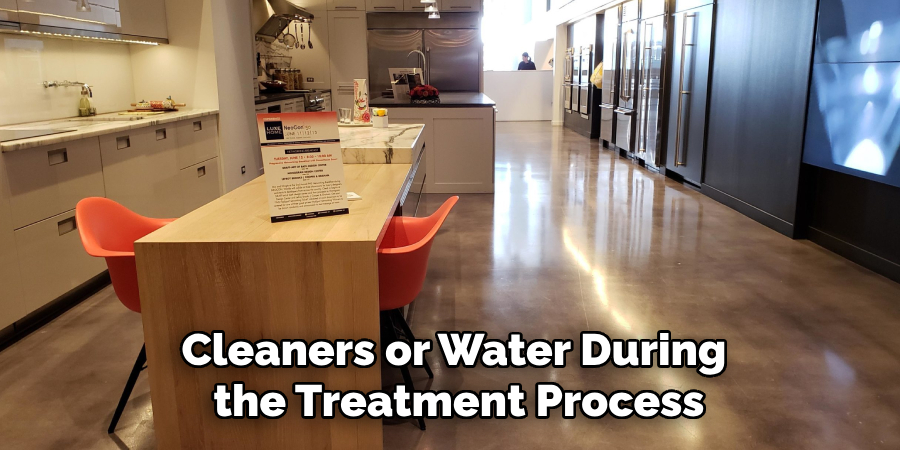
Begin by removing all items from the countertop, including appliances, utensils, décor, and any personal belongings. An apparent surface ensures you won’t miss any spots during the cleaning process. Additionally, this step prevents potential damage to items that could be affected by cleaners or water during the treatment process. Properly store any removed items in a safe location while you work on your marble countertop.
Step 2. Dust the Surface:
Remove any loose dust or debris from the marble countertop using a soft, dry microfiber cloth or a duster. This step prevents scratching the surface when cleaning and ensures that dirt particles do not interfere with the next steps in the treatment process. Be thorough, especially around edges and corners, to achieve an immaculate surface.
Step 3. Prepare a Cleaning Solution:
Mix a gentle cleaning solution that is safe for natural stone surfaces to clean your marble countertop properly. Combine warm water with a few drops of mild dish soap, ensuring that the soap is non-acidic and free of harsh chemicals. Acidic or abrasive cleaners can damage the delicate surface of marble, dulling its shine or even causing etching. Stir the mixture until it creates a light foam, but avoid using too much soap, as excess residue may be difficult to rinse off later. Pour the solution into a clean spray bottle for easy application.
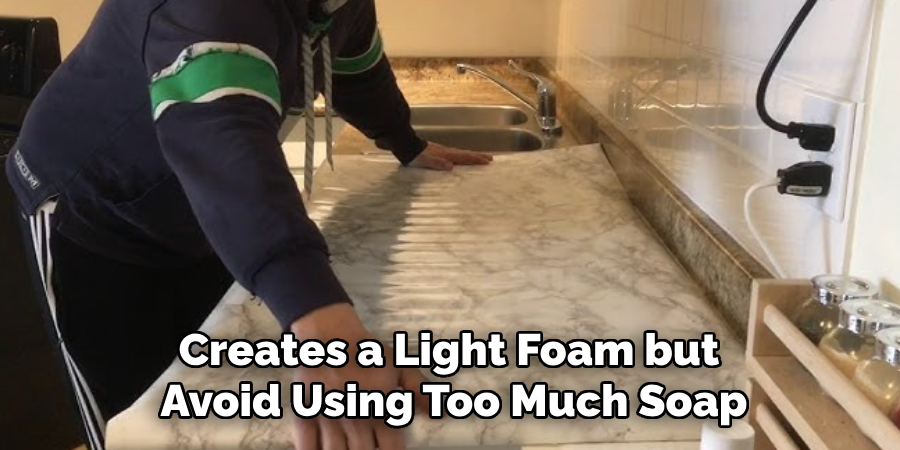
If you prefer, you can also use a commercially available stone-safe cleaner specifically designed for marble. Always consult the product instructions before use to ensure compatibility with your countertop.
Step 4. Apply the Cleaning Solution:
Spray the cleaning solution evenly onto the marble countertop, focusing on small sections at a time. Allow the solution to sit for a minute to loosen any dirt or grime, but do not let it dry completely on the surface. Using a soft, non-abrasive microfiber cloth or sponge, gently wipe the solution in a circular motion to lift dirt and stains. Be careful not to scrub too hard, as excessive pressure can damage the marble’s surface. For stubborn spots or spills, apply more solution and continue gently wiping until the area is clean. Always work methodically to ensure no areas are missed.
Step 5. Rinse and Dry the Surface:
Once the marble countertop has been cleaned, it is essential to rinse off any remaining cleaning solution to avoid residue buildup. Use a clean, damp microfiber cloth to thoroughly wipe down the surface, removing all solution traces. After rinsing, immediately dry the countertop with a separate dry microfiber cloth to prevent water spots or streaks. Proper drying also helps to protect the marble’s finish and maintain its natural shine.
Step 6. Apply a Marble Sealant:
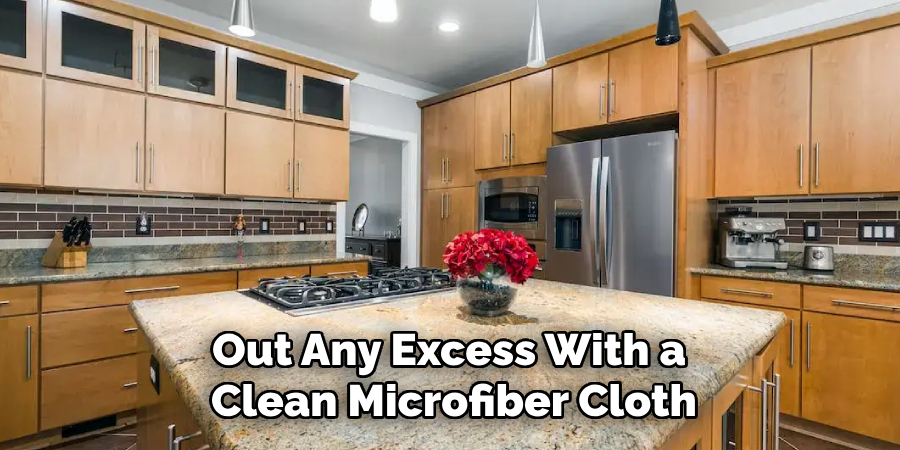
Applying a high-quality marble sealant is highly recommended to preserve the beauty and longevity of your marble countertop. This step helps to protect the porous surface from stains, spills, and etching caused by everyday use. Before starting, ensure the countertop is completely clean and dry. Following the manufacturer’s instructions, evenly apply the sealant with a soft cloth or applicator pad in a thin, uniform layer. Allow the sealant to penetrate the surface for the recommended time, then buff out any excess with a clean microfiber cloth. Repeat this process as necessary, based on the type of sealant used and the level of protection desired. Regular resealing will help maintain the countertop’s durability and appearance over time.
Step 7. Maintain Regular Cleaning Habits:
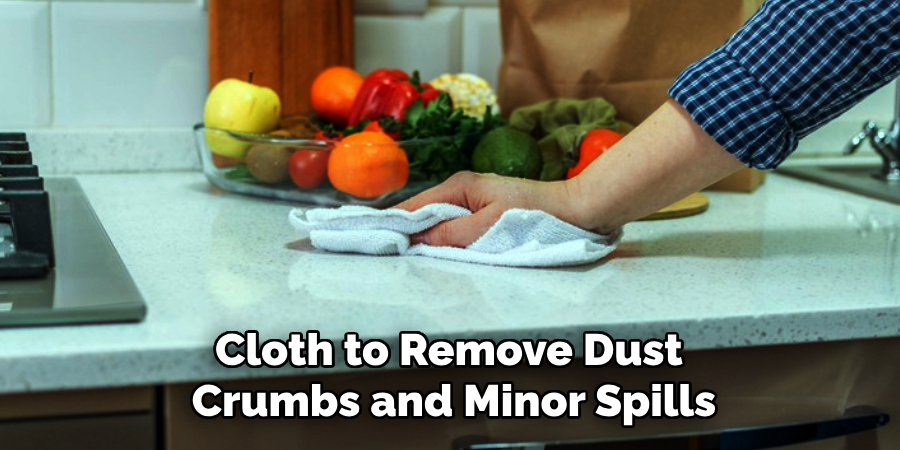
Establish a routine cleaning schedule to keep your marble countertop looking its best. Wipe down the surface daily with a soft, damp microfiber cloth to remove dust, crumbs, and minor spills. For deeper cleaning, use a pH-neutral stone cleaner as needed, ensuring that it is safe for use on marble surfaces. Avoid acidic or abrasive cleaners, which can damage the natural stone and dull its finish. By maintaining consistent cleaning habits, you can preserve the elegance and longevity of your marble countertop.
Step 8. Address Stains Promptly:
If a spill occurs on your marble countertop, it is essential to clean it up immediately to prevent staining. Use a soft cloth or paper towel to blot the spill—avoid wiping, as this can spread the liquid further. Create a poultice using baking soda and water or a specialized marble stain remover for stubborn stains. Apply the poultice to the affected area, cover it with plastic wrap, and allow it to sit for 24 to 48 hours. Once dried, gently remove the poultice and rinse the area with water. Prompt and proper treatment will help prevent permanent discoloration and keep your countertop looking pristine.
Step 9. Protect the Surface:
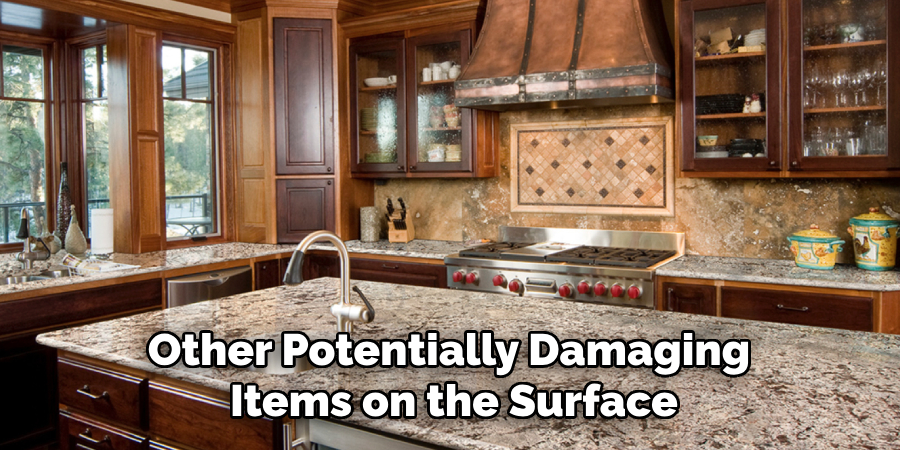
To prevent scratches, etches, or stains on your marble countertop, use coasters, trivets, and placemats whenever placing drinks, hot pots, or other potentially damaging items on the surface. Avoid cutting directly on the marble, as this can leave marks and dull the finish over time. Utilizing protective measures will help safeguard the beauty and durability of your marble countertop for years to come.
By following these simple steps, you can keep your marble countertop clean and well-maintained, preserving its elegance and natural beauty.
5 Things You Should Avoid
- Using Harsh Cleaners: Avoid using acidic or abrasive cleaners, such as vinegar, lemon juice, or bleach, as they can etch or dull the surface of the marble over time.
- Leaving Spills Unattended: Marble is porous and can stain easily. Leaving spills on the surface, especially of wine, coffee, or oil, can lead to permanent discoloration.
- Cutting Directly on the Surface: Never use marble countertops as a cutting board. Sharp objects can scratch the surface and damage the polished finish.
- Placing Hot Pots or Pans Directly on the Marble: Exposing marble to high temperatures can cause discoloration or cracks. Always use trivets or hot pads to protect the surface.
- Neglecting Regular Sealing: Failing to seal your marble countertops regularly can make them more susceptible to stains and damage. Ensure routine maintenance to keep your countertops in pristine condition.
What is the Best Finish for Marble Countertops?
When it comes to marble countertops, various types of finishes are available that not only enhance the beauty of the stone but also provide necessary protection. Each finish has its own unique characteristics and can cater to different needs and preferences. Here are some popular options for finishing marble countertops:
- Polished: This is the most common and traditional finish for marble countertops. It gives the surface a glossy, mirror-like shine, making it smooth to touch. This finish is achieved by grinding and buffing the surface with fine abrasives, resulting in a highly reflective appearance.
- Honed: Honed finish provides a smooth yet matte appearance to the marble countertop. It has a soft sheen that is less reflective than polished, making it ideal for a more subtle and understated look. This finish is achieved by sanding the surface with coarse abrasives, giving it a smooth but non-reflective appearance.
- Leathered: Leathered finish adds texture to the marble countertop, providing a unique and rustic look. It has a matte appearance with a slight sheen, giving the stone a leather-like texture. This finish is achieved by brushing and buffing the surface with diamond-tipped brushes.
- Antiqued: Also known as tumbled or distressed finish, this option gives the marble countertop an aged and weathered look. It has a rougher surface with rounded edges, giving it a rustic and natural appearance. This finish is achieved by tumbling the stone in a machine with abrasive materials.
Regardless of which finish you choose, it is essential to properly maintain and seal your marble countertops to keep them looking beautiful for years to come.
Conclusion
How to treat marble countertops with proper care is essential to preserve their beauty and durability.
Regular cleaning with a mild, pH-neutral cleaner can help prevent stains and etching caused by acidic substances. Always use coasters, trays, and cutting boards to protect the surface from scratches or spills. Sealing your marble countertop periodically is crucial in maintaining its resistance to moisture and staining, especially for polished and honed finishes. Avoid using harsh chemicals or abrasive tools that can damage the surface.
By following these simple maintenance steps, you can ensure your marble countertops remain a timeless and elegant feature in your home for years to come.
Professional Focus
Angela Ervin, a former interior designer turned blogger, specializes in kitchen design and renovations. Through her website, she blends her passion for cooking with design expertise, sharing practical and creative ideas. Known for balancing functionality and beauty, Angela’s insightful content has made her a trusted voice in home design and lifestyle.
About the Author
Angela Ervin, an experienced interior designer and blogger, combines her passion for kitchen renovations with storytelling. Living in Petersburg with her family, she enjoys cooking and testing her projects firsthand. Known for her humor and relatable style, Angela shares creative, functional design insights through her content, making her a trusted voice in home design.
Education History
University: Virginia Commonwealth University
Degree: Bachelor of Fine Arts (BFA) in Interior Design
- Angela’s education at VCU focused on mastering core interior design principles, including spatial planning, color theory, materials selection, and sustainable design practices.
- She gained hands-on experience through studio projects and collaborative design exercises, which honed her ability to create functional and aesthetically pleasing environments.
- Her coursework also emphasized problem-solving and practical applications of design, preparing her for real-world projects like her self-directed kitchen renovations.
- The program’s strong foundation in both technical skills and creative expression shaped Angela’s ability to seamlessly integrate form and function in her work.
